Learninsta presents the core concepts of Biology with high-quality research papers and topical review articles.
Vascular Tissue System
This section deals with the vascular tissue system of gymnosperms and angiosperms stems and roots. The vascular tissue system consists of xylem and phloem. The elements of xylem and phloem are always organized in groups. They are called vascular bundles.
The stems of both groups have an eustele while roots are protostele. In eustelic organization, the stele contains usually a ring of vascular bundles separated by interfascicular region or medullary ray. The structural and organizational variation in vascular bundles is shown below.
Types of Vascular Bundles


Vascular tissue is comprised of the xylem and the phloem, the main transport systems of plants. They typically occur together in vascular bundles in all plant organs, traversing roots, stems, and leaves. Xylem is responsible for the transport of water and dissolved ions from the roots upwards through the plant.
Vascular tissue transports water, minerals, and sugars to different parts of the plant. Vascular tissue is made of two specialized conducting tissues: xylem and phloem. Xylem tissue transports water and nutrients from the roots to different parts of the plant, and also plays a role in structural support in the stem.
The plant vascular system is a complicated network of conducting tissues that interconnects all organs and transports water, minerals, nutrients, organic compounds, and various signaling molecules throughout the plant body.
Vascular tissues perform essential roles in integrating the physiological (transport of water and nutrients), developmental (transport of signaling molecules) and structural (physical support) processes of higher plants.
Vascular tissues are complex conducting tissues of the plant. The main function of the tissues is transporting water, minerals, and organic compounds to different parts of the plants. The tissue is composed of two conducting systems – xylem and phloem.
Vascular tissue is comprised of the xylem and the phloem, the main transport systems of plants. They typically occur together in vascular bundles in all plant organs, traversing roots, stems, and leaves.
Vascular tissue is a complex conducting tissue, formed of more than one cell type, found in vascular plants. The primary components of vascular tissue are the xylem and phloem. These two tissues transport fluid and nutrients internally. The cells in vascular tissue are typically long and slender.
Types of Vascular plants. The vascular plants have a membrane-bound nucleus, so they are called eukaryotes. Some of the tracheophytes reproduce from seed while some reproduce from spores. There are two types of vascular plants: cryptogams and phanerogams.
With their large fronds, ferns are the most readily recognizable seedless vascular plants. They are considered the most advanced seedless vascular plants and display characteristics commonly observed in seed plants. More than 20,000 species of ferns live in environments ranging from tropics to temperate forests.
Vascular tissues in the human body have blood vessels like veins, arteries and capillaries, while avascular tissues do not. For example, muscle tissue is vascular, or vascularized. Cartilage is another type of avascular tissue.
Vascular plants include the clubmosses, horsetails, ferns, gymnosperms (including conifers) and angiosperms (flowering plants). Scientific names for the group include Tracheophyta, Tracheobionta and Equisetopsida sensu lato.
Vascular cambium is the tissue very much sensitive to mechanical injuries, such as wounding or grafting. However, it can easily regenerate under suitable conditions.
The ferns, gymnosperms, and flowering plants are all vascular plants. Because they possess vascular tissues, these plants have true stems, leaves, and roots.
Seedless vascular plants include ferns, horsetails and clubmosses. These types of plants have the same special tissue to move water and food through their stems and foliage, like other vascular plants, but they don’t produce flowers or seeds. Instead of seeds, seedless vascular plants reproduce with spores.
Connective tissues can have various levels of vascularity. Cartilage is avascular, while dense connective tissue is poorly vascularized. Others, such as bone, are richly supplied with blood vessels.
Non-vascular plants do not have a wide variety of specialized tissue types. Mosses and leafy liverworts have structures called phyllids that resemble leaves, but only consist of single sheets of cells with no internal air spaces no cuticle or stomata and no xylem or phloem.
Muscle tissue is composed of cells that have the special ability to shorten or contract in order to produce movement of the body parts. The tissue is highly cellular and is well supplied with blood vessels.